Balancing grad school, work, and family life has proven to be a challenge, and unfortunately I have been forced to take a bit of a temporary hiatus from my food history projects. However, I couldn’t let the holiday season come and go without putting something out there! So today I am posting one of my little collections of archived historic material for your reading pleasure.
The topic is Thanksgiving! I’ve focused on American Thanksgiving because the Canadian one was back in October. If you are familiar with American Thanksgiving, you may know that the origin story is a bit murky and controversial. I am not here to educate anyone about the true history behind the holiday. This post is focused squarely on the food. To me, Thanksgiving represents: 1. Unity 2. Gratitude and, of course, 3. Food.
One thing that is important to note is that the Thanksgiving feast is, in a lot of ways, a celebration of indigenous ingredients! Turkey, corn, potatoes, green beans, pumpkins and squash are all native to the Americas and were unknown to Europe before the 16th century. Most traditional Thanksgiving meals incorporate one or all of these foods.
If you are interested in learning more about indigenous American food from the people who know best, check out I-Collective’s multimedia cookbook, A Gathering Basket.
Thanksgiving Recipes, Menus, etc.
Below is a selection of Thanksgiving recipes and links to old cookbooks, magazines and holiday manuals. Maybe this year you can incorporate a historic recipe into your own holiday celebration! This is barely scratching the surface of what is out there, but I’ve done my best to compile a nice variety of materials for you to peruse. I decided to limit my search to texts dated between 1740 and 1940. There are only so many hours in the day.
Enjoy!
Turkey Sauce and Carrot Fritters
From Miss Anne Burton’s, A Book of Choice Receipts in Cookery (1742).
This is actually not an “American” text, since the manuscript was most likely written in London. I haven’t been able to find much information about Anne Burton, but the fact that it is included in Harvard’s Schlesinger Library, which is dedicated to the history of women in the United States, was enough for me to justify including it here. Americans were still considered British in 1742 and though there were cultural and regional differences, food preparation would have been pretty similar.
Squash Pudding and Turkey Stuffing
From American Cookery, written by Amelia Simmons (1796)
These recipes are from my personal collection. I have a facsimile print copy of American Cookery, which is widely considered to be the first truly American cookbook. It was originally published in the United States in 1796 with an absurdly long subtitle by “Amelia Simmons, an American Orphan.” I wrote out the text as it appears in the book, but you can read the full digitized version here.
A Crookneck, or Winter Squash Pudding
Core, boil and skin a good squash, and bruize it well; take 6 large apples, pared, cored, and stewed tender, mix together; add 6 or 7 spoonsful of dry bread or biscuit, rendered fine as meal, half pint milk or cream 2 spoons of rose-water, 2 do. wine, 5 or 6 eggs beaten and strained, nutmeg, salt and sugar to your taste, one spoon flour, beat all smartly together, bake.“American Cookery,” p. 27-28
The above is a good receipt for Pompkins, Potatoes or Yams, adding more moistening or milk and rose water, and to the two latter a few black or Lisbon currants, or dry whortleberries scattered in, will make it better.
To Stuff a Turkey.
Grate a wheat loaf, one quarter of a pound butter, one quarter of a pound salt pork, finely chopped, 2 eggs, a little sweet marjoram, summer savory, parsley and sage, pepper and salt (if the pork be not sufficient,) fill the bird and sew up.
“American Cookery,” p. 18
Turkey and Gravy
From Tunis Campbell’s Hotel Keepers, Head Waiters and Housekeeper’s Guide, 1848
This recipe also doesn’t explicitly mention Thanksgiving, but it still fits the parameters of my search. Tunis Campbell was a well-respected abolitionist and is considered to be one of the first known African American authors of a cookbook. Campbell was later elected as a Georgia state senator in 1868. The guide was written when Tunis was a hotel steward, so only a portion of it is dedicated to recipes. The rest concerns hotel management with chapters on topics like proper attire, table settings and squad drills.
Pudding and Pies
From Ladies Indispensable Assistant, 1850
There appears to be no author, but the publisher is F.J. Dow and Co. I love the enthusiastic full title that covers everything from etiquette to canary birds. Whoever wrote this declared it to be “one of the best systems of cookery every published” and “should be in possession of every person in the land.”
Thanksgiving Cake
From Portsmouth Monumental Cookbook, 1874
This cookbook was written by the Soldiers’ Aid Society of Ohio, which was an organization of women that was formed during the Civil War to provide Northern soldiers with supplies.
“Let the Turkeys Live”
“Thanksgiving Dinners” in The Health Reformer vol. 9 no. 1, 1874.
The Health Reformer magazine was first published in 1866 by the Seventh-Day Adventist religious group under the direction of Ellen and James White. In 1874, after this volume was published, John Harvey Kellogg became the editor of the magazine, which was renamed Good Health five years later.
I couldn’t resist including this article, which calls for a turkey-free Thanksgiving meal not only for the benefit of the animals, but especially for the health of the poor overworked housewives.


Thanksgiving pudding, Cranberry Sauce & Pies
From Good Housekeeping Vol. 8, Nov 10 1888
This is an excellent resource for learning about Victorian-era Thanksgiving. You’ll find morbid poetry, housekeeping and etiquette tips, menus, articles about avoiding fire hazards, and a lot of recipes.
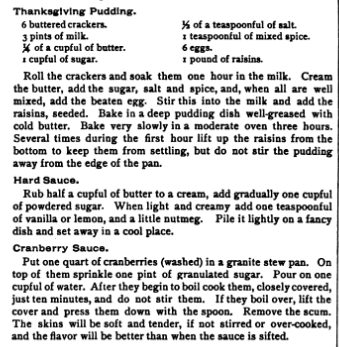


A Crisp Salad
From The Boston Cooking School Magazine Vol 8 No. 4, 1903
The dishes in this magazine are a bit on the fancy side, with things like chestnut aspic and squash timbales. The menu suggests serving clam broth but the book does not include a recipe for it. You’re in luck, though, because I posted one last year: Clam Bouillon Demi Tasse, 1905.


Vegetarian Menu and Michaelmas Loaf
From Six Hundred Recipes for Meatless Dishes by Maud R. L. Sharpe, 1908.
An off-the-beaten-path search led me to this unique cookbook that might appeal to my vegetarian friends. The menu suggests Michaelmas Loaf as the main entree, which is interesting because Michaelmas is celebrated in September. Based on the ingredients, the loaf probably tastes a lot like Stuffing.


Sweet Potatoes
From Institution recipes for use in schools, colleges, hospitals and other institutions, 1912.
Emma Smedley, the author and publisher, was a very accomplished woman. She served as Superintendent of High School Luncheons, Instructor of Domestic Science at Drexel Institute and Instructor in Dietetics at John Hopkins Institute. This book is a revision of the first edition originally published in 1904. The book is about managing an institutional luncheon system, so the recipes are geared toward serving large groups of people.

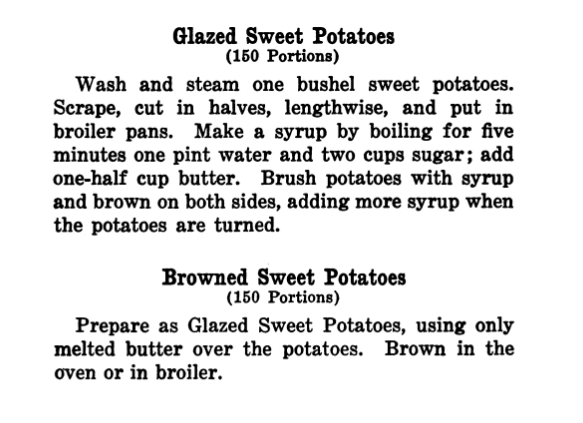
Sweet Cider Frappe, Pumpkin Fanchonettes, etc.
From American Cookery Vol. XXVI, No. 4 (November, 1921).
If I had to choose just one historic Thanksgiving recipe resource to build a period feast, this would be the one. This magazine has loads of recipes, and as an added bonus you can read about tiny houses and somebody’s cat.



Fried Oysters and Harvard Beets
From “A 4-H Girl Sets the Holiday Table,” a radio transcript from 1927.
I just love this cheesy radio transcript. The first story is about setting a table and the second is about a collegian returning home for Thanksgiving excited to eat Fried Oysters and Harvard Beets. I’ve been surprised by how many Thanksgiving menus include oysters, so it would be a shame to not post one.
Zwieback, Pudding and Pineapple Stars
From Modern Kosher Meals by Mildred Bellin, 1934
I was very excited to find this Jewish recipe book. It is arranged by month with suggested menus and a handful of seasonable recipes. Honestly, the greatest disappointment was that each chapter is so short! November is covered on pages 83-89.
Cranberry Chiffon Pie
From “Thanksgiving Questions and Answers,” a radio broadcast from November 27, 1934.
I feel for the poor housewife who had to call in to a radio show only two days before Thanksgiving to ask whether or not to cook the turkey with the cover on.
Bread Rolls
From Ruth Wakefield’s Tried and True Toll House Recipes, 1940
Ruth Wakefield’s book is half household guide and half recipes. I found the first aid section to be much more interesting and useful than everything else. Way too many canapé recipes for my taste. Despite the prominent photo of a Thanksgiving table near the beginning of the book, holiday food is shockingly neglected. So I just decided to include some bread rolls to keep our historic menu well-rounded.
I’ve been trying to identify what is in the serving tray on the table. It looks like beets, yams, and possibly some very large creamed brussels sprouts?
Buttered Brussels Sprouts
From 250 Ways to Serve Fresh Vegetables, 1940
This book does not mention Thanksgiving at all, but I keep seeing buttered brussels sprouts on holiday menus from the 1930’s and 1940’s and thought I should include one here. This one stood out because of the parchment paper.
Cottage Cheese Pineapple Fritters
From The New Sealtest Book of Recipes and Menus, 1940
Last but not least is a great book to represent the changing food trends. Midcentury American food was all about modernization. Futuristic and experimental recipes made with new kitchen tools and canned foods were all the rage. This particular recipe isn’t especially mind-blowing, but it is noteworthy for being created by the Sealtest experimental kitchen and featured in a somewhat untraditional Thanksgiving dinner.
Additional Resources
I could spend hours looking through non-food-related historical documents. But for my own sanity, I forced myself to stay on task and focused on food. If you’re interested in learning more about Thanksgiving holiday traditions, official proclamations and the origin stories, a great place to start is The Library of Congress teacher’s guide to Thanksgiving primary sources.
Bibliography
All of the primary sources I used are linked within the post, but you can find the full citations in the list below. Some of the images are downloads, others are screenshots, but all are in the public domain.
- Bellin, Mildred. Modern Kosher meals: recipes and menus arranged for each month of the year based on current food supplies. New York: Bloch publishing company, 1934. https://hdl.handle.net/2027/wu.89042017772
- Berolzheimer, Ruth, and Culinary Arts Institute. 250 Ways to Serve Fresh Vegetables. Chicago: Culinary Arts Institute, 1940.
- Boston Cooking School Co. American Cookery Vol 26 No. 4 (November, 1921). https://hdl.handle.net/2027/mdp.39015074940829
- Boston Cooking School Co. The Boston Cooking School Magazine Vol 8 No. 4 (November, 1903). https://hdl.handle.net/2027/mdp.39015036669920
- Burton, Anne. A Book of Choice Receipts in Cookery. 1742, London? Sophie D. Coe Manuscript Cookbook Collection, 1704-1968. MC 844, folder 1.2v. Schlesinger Library, Radcliffe Institute, Harvard University, Cambridge, Mass. https://nrs.harvard.edu/urn-3:RAD.SCHL:38210593
- Campbell, Tunis G. Hotel Keepers, Head Waiters, and Housekeepers’ Guide. Boston: Coolidge and Wiley, 1848. MSU Libraries. https://d.lib.msu.edu/fa/42
- Good Housekeeping Vol. 9 (November 10 1888-April 1889) https://hdl.handle.net/2027/umn.31951p00998528o
- Sealtest, Inc., Sealtest Laboratory Kitchen. The new Sealtest book of recipes and menus. New York: Sealtest, 1940. https://hdl.handle.net/2027/uiug.30112076889150
- Simmons, Amelia. American cookery, or, The art of dressing viands, fish, poultry, and vegetables: and the best modes of making pastes, puffs, pies, tarts, puddings, custards, and preserves: and all kinds of cakes, from the imperial plumb to plain cake, adapted to this country, and all grades of life. Hartford: Printed by Hudson & Goodwin for the Author, 1796.
- Sharpe, M. R. L. (Maud Russell Lorraine). Six hundred recipes for meatless dishes. Cambridge: The University press, 1908. https://hdl.handle.net/2027/nyp.33433056931532
- Simmons, Amelia. The First American Cookbook: A Facsimile of “American Cookery,” 1796. Forward by Mary Tolford Wilson. New York: Dover Publications, Inc, 1958.
- Smedley, Emma. Institution recipes for use in schools, colleges, hospitals and other institutions. Media, Pa.: Emma Smedley, 1912.
- Soldiers’ Aid Society. Portsmouth monumental cook book. Portsmouth, Ohio: J. W. Newman, printer, 1874. https://hdl.handle.net/2027/loc.ark:/13960/t0xp7h53m
- Ladies’ indispensable assistant: Being a companion for the sister, mother, and wife … Also, safe directions for the management of children … a great variety of valuable recipes, forming a complete system of family medicine … To which is added one of the best systems of cookery. New-York: F.J. Dow & Co., 1850. https://hdl.handle.net/2027/nyp.33433006785020.
- United States Department of Agriculture. “Thanksgiving Questions and Answers,” November 27, 1934. Radio transcript. https://archive.org/details/thanksgivingques1934unit/page/n3/mode/2up?ref=ol
- United States Department of Agriculture. “A 4-H Club Girl Sets the Holiday Table.” November 23, 1927.https://archive.org/details/4hclubgirlsetsho1927unit/page/n1/mode/2up
- Wakefield, R. Graves. Ruth Wakefield’s Toll house tried and true recipes. “Eleventh printing (revised)” New York: M. Barrows & company, inc., 1940. https://hdl.handle.net/2027/coo.31924003573643
- White, James (editor). The Health Reformer vol. 9 no. 1 (January, 1874). https://hdl.handle.net/2027/mdp.39015076974214





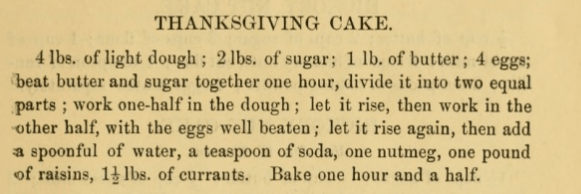


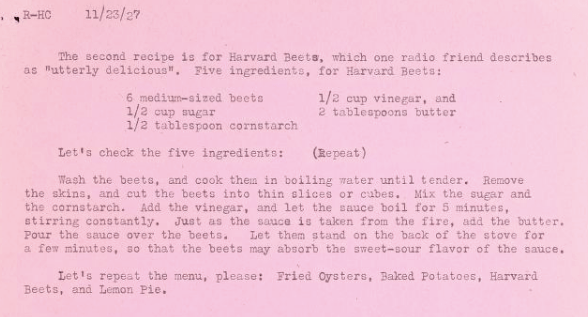

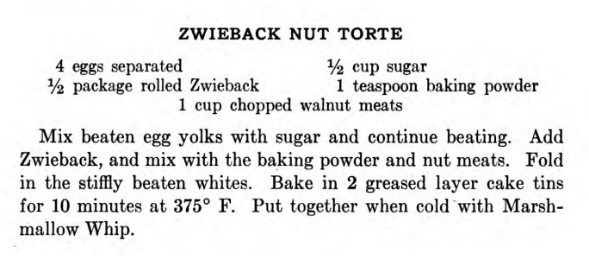




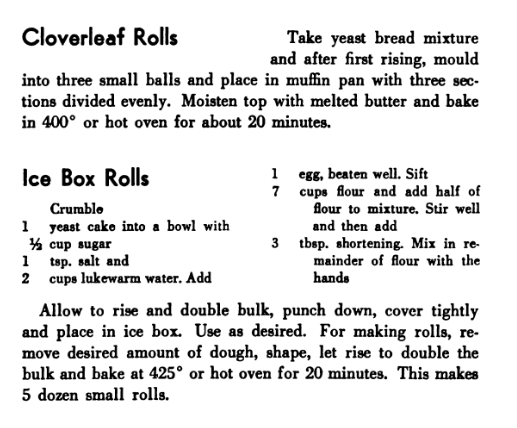


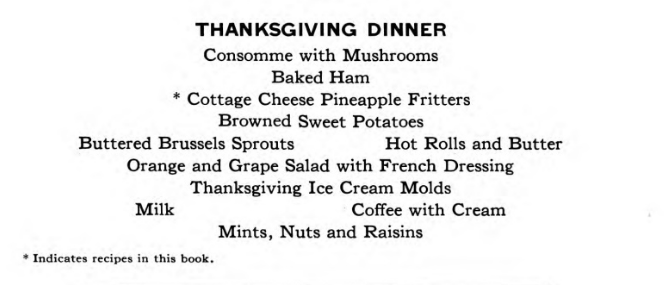

Great article Sarah! I might have to try making the Michaelmas loaf. Sounds good! It all does. Happy turkey day to ye! Enjoy.
LikeLiked by 2 people
Thanks Lisa! And a Happy Turkey Day to you too. 🙂
LikeLike
Good article. Thanks for sharing.
LikeLiked by 1 person